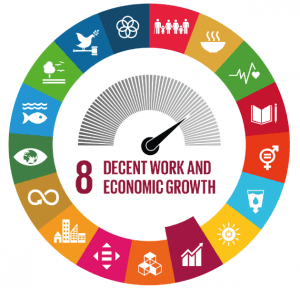Every 28th April marks the World Day for Safety and Health at Work, and this year ILOSTAT commemorates it by honouring labour inspectors. We delve into available data on labour inspectors and their activities to understand how well-equipped they are to enforce labour laws including occupational safety and health laws.
Nearly 3 million people died of work-related accidents and diseases in 2019, most of them caused by occupational diseases (89%) and about 11% due to work accidents, according to ILO estimates. There were also 395 million workers who sustained non-fatal work injuries. A joint WHO/ILO study revealed that exposure to long working hours was the risk factor with the largest work-related burden of disease in 2016, causing over 39% of deaths attributable to occupational diseases that year. In this context, the International Labour Conference added safety and health to Fundamental Principles and Rights at Work in 2022.
Labour inspection plays a key role in the promotion of a safe and healthy work environment and, more generally, in the attainment of decent working conditions for all.
To date, 150 countries have ratified the ILO Labour Inspection Convention, 1947 (No. 81) which calls for, amongst other things, labour inspectors to secure the enforcement of the legal provisions relating to conditions of work and the protection of workers while engaged in their work, including on safety, health and welfare of workers.
While traditional labour market challenges remain and often intensify, new challenges emerge. As informality remains pervasive, globalization and digitization intensify, and changes unfold in work relationships, strengthening labour inspection is as crucial as ever to protect workers and ensure compliance with labour law. However, resource constraints affecting many labour inspectorates around the world coupled with legislative and institutional reforms make it difficult for them to perform their role efficiently and effectively.
Number of labour inspectors
According to the Guidelines on general principles of labour inspection, the number of labour inspectors needed to fulfil the labour inspection mandate adequately depends on the context. This includes the number, nature, size, and situation of workplaces liable to inspection, the number of workers, the number and complexity of legal provisions to be enforced, the equipment and resources available to the inspectorate, etc. Thus, applying a ratio exclusively based on the number of labour inspectors per a given number of workers or workplaces is not suitable. However, even if such a benchmark ratio does not exist, in many countries the number of labour inspectors is insufficient given the extent of their responsibilities and the rising complexities of the labour market. A 2013 study found that in most of the 15 European countries surveyed, the number of labour inspectors was inadequate to monitor and enforce labour standards including those related to safety and health, especially in a crisis context of increased demand for their services and limited resources.
ILOSTAT data show that the number of labour inspectors varies from country to country, naturally linked to the size of the economy and the employed population, but the ratio of inspectors per 10’000 employed does not exceed 4 anywhere in the world, based on the latest data points available. In fact, in half of the 78 countries with data, there are less than 0.58 inspectors per 10’000 workers. The median ratio is a bit higher in high-income countries, with 0.84 inspectors per 10’000 workers compared to 0.41 in upper-middle-income countries and 0.47 in lower-middle and low-income countries.
Analyzing the global trend in the number of labour inspectors is challenging given data gaps and patchy time series. Nonetheless, out of 75 countries with data in ILOSTAT, in 43% the number of labour inspectors has decreased between 2009 and 2022 (or the closest available years) while employment increased. Efforts to reduce public expenditure and austerity measures have led some governments to cut inspectorate staff or not replace retiring inspectors, especially in response to economic crises. In some contexts, the type of contract, status, and working conditions of inspectors are worsening too, leading to a deskilling of inspectors often accompanied by cuts in equipment and material resources, affecting the effectiveness of the inspectorate.
This is all the more worrying in a world where inspectors’ tasks are becoming more challenging, with changing labour markets requiring them to keep adapting to new realities.
Labour inspectors and gender
Labour inspection must be gender-responsive to ensure labour standards are effectively applied to everyone. A gender-responsive labour inspection helps promoting the occupational safety and health of all workers and addressing occupational risks women are disproportionately exposed to, including discrimination, violence, and harassment at work. Promoting gender awareness throughout the inspection system is essential, and increasing the share of female labour inspectors is a key part of that, as is training inspectors to identify and address violence and discrimination. Indeed, health hazards faced by women workers have traditionally been underestimated because occupational safety and health standards and exposure limits to hazardous substances are based on male populations. The long-standing focus on industries with predominantly male workforces implies that risks, hazards and accidents of these industries are better known and better addressed (for instance, efforts to ensure the safety of workers doing heavy lifting are common in construction but less so in care work).
The situation is encouraging for the quest to achieve gender parity for labour inspectors: the average share of female inspectors across 79 countries with data is 46%, while in 58% of countries with data the female share of inspectors is higher than the female share in total employment.
However, major challenges remain to ensure safety and health of all women at work. Women are often over-represented in sectors, occupations and types of workplaces especially challenging for labour inspection to cover, such as the informal economy, rural undertakings, domestic work and other work conducted in homes.
Inspection workplace visits
According to the Guidelines on general principles of labour inspection, the mandate of labour inspection should apply equally to all workers and all workplaces in all sectors, whether private or public, rural or urban, formal or informal, and most of inspectors’ time should be devoted to visiting workplaces so they can be as closely in touch as possible with the establishment, employers and workers. Labour inspectorates should also consider that most vulnerable groups of workers often do not submit complaints to the labour inspectorate and keep a proper balance between reactive and proactive inspection visits.
ILOSTAT includes data on workplace visits conducted by labour inspectors during the year, referring to all visits (whether first visits or follow-up visits, reactive or proactive visits, visits of any duration, etc.). The ratio of visits to inspectors varies considerably around the world, ranging from only a few visits per inspector on average in a year in some countries to several visits per day on average per inspector in others. In half of the 83 countries with data, each labour inspector conducted on average more than 86 workplace visits in the reference year. The median number of visits per inspector is a little higher in high-income countries, at 88 compared to 73 in upper-middle-income countries and 74 in lower-middle and low-income countries.
Recognizing that the ideal share of workplaces proactively visited per year depends on the context, it is still worth noting that in 87% of the 75 countries with data, the number of visits conducted was less than the number of workplaces liable to inspection, and in 71% of countries with data it was less than half of the number of workplaces liable to inspection (noting that some workplaces could have been visited more than once).
The increasingly fast-paced changes in labour markets and work environments call for modern labour inspection systems to make effective use of information and communication technologies to improve their performance, for example by allowing electronic monitoring, virtual engagement with workplaces and workers, and inspections planning based on data analysis. The impact and effectiveness of workplace inspection visits can particularly benefit from the use of modern technologies.
Challenges of fast-changing labour markets
Labour markets are changing around the world, with new trends emerging while some long-standing patterns remain or even intensify. Globalization is still having an impact on various aspects of employment. Subcontracting and labour intermediaries are becoming more common. Informality remains pervasive, while the boundary between paid employment and self-employment is blurring and work relationships are changing. Working arrangements are evolving as well, with teleworking and remote work gaining ground. Casual work, unpaid work, and home-based work remain significant in some contexts. Setting aside undeclared or unregistered employment, non-compliance with labour standards is frequent in domestic work, home-based work, rural work, and in micro and small sized enterprises. Meanwhile inspectors often do not have the authority to enter workplaces located within private homes and have difficulties accessing others, hindering their supervisory role.
Indeed, the Committee of Experts on the Application of Conventions and Recommendations noted in 2019 the many challenges some labour inspection systems around the world face which hamper their effectiveness, such as moratoria on labour inspections, requirements of prior notification of a visit to employers, restrictions on unannounced inspections, limits to the frequency, duration and scope of inspections, exemptions from inspections to a significant portion of enterprises, substantial cuts to the number of labour inspectors and resources allocated to them, and assignment of additional tasks to labour inspectors preventing them from focusing on their primary duties and damaging their authority and impartiality, to name a few.
All of this conveys the complexity of safety and health issues and how labour inspectors’ tasks are becoming increasingly complicated. Labour inspectors are currently dealing with many different work arrangements, contract types, and kinds of enterprises, some within complex production systems. Training and expertise are needed to identify these complex realities and address emerging issues.
Labour inspection plays a pivotal role in the enforcement of fundamental labour rights including occupational safety and health. However, labour inspectorates must be sufficiently staffed and equipped to be up to the task.
Key resources on occupational safety and health statistics

Quick Guide on sources and uses of statistics on occupational safety and health
This guide gives an overview of the main aspects of occupational safety and health statistics, including their relevance and uses.

Guide on the Harmonization of Labour Inspection Statistics
This publication provides a methodology for the use of common terms and definitions and common procedures for the collection and compilation of labour inspection data. It also incorporates several additional recommendations that further the objective of harmonizing labour inspection statistics.
Author
-
Rosina Gammarano
Rosina is a Senior Labour Statistician in the Statistical Standards and Methods Unit of the ILO Department of Statistics. Passionate about addressing inequality and gender issues and using data to cast light on decent work deficits, she is a recurrent author of the ILOSTAT Blog and the Spotlight on Work Statistics. She has previous experience in the Data Production and Analysis Unit of the ILO Department of Statistics and the UN Resident Coordinator’s team in Mexico.










